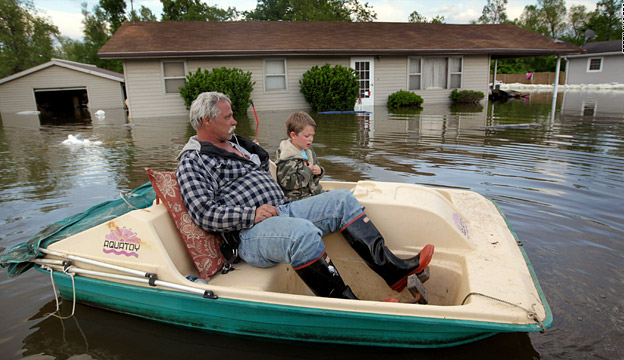
Tunica, Mississippi (CNN) — The swollen Mississippi River rolled south Wednesday, swamping emptied-out towns and businesses, and threatening untold damage to areas still recovering from a series of natural disasters.
In Mississippi, Louisiana, and Arkansas, authorities and residents braced for the days ahead.
"I went through (Hu rricane) Katrina," said Lynn Magnuson, a New Orleans resident. "I would not wish flooding on anyone, and this city is the last place on Earth that needs any more high water."
The river crested Tuesday at Memphis, just short of a record set in 1937.
The river in Memphis measured 47.8 feet Tuesday night, according to the National Weather Service. Flood stage in Memphis is 34 feet.
In Natchez, Mississippi, the river surpassed its record early Wednesday, exceeding 58 feet. Forecasts predict the river will crest in Natchez on May 21 at an overwhelming 64 feet. Flood stage in Natchez is 48 feet.
Mississippi has already had to close some of its casinos at Tunica, a key economic driver in that part of the state, as flood waters seeped in.
About 600 people in the community of Tunica Cutoff have been driven from their homes, said Larry Liddell, a county spokesman.
"My house is completely submerged. You can't even see it from a photograph," said Michael Dewes, who fled the Tunica Cutoff community and is staying in a shelter. "It's completely gone."
In Louisiana, Gov. Bobby Jindal said as many as 3 million acres could be affected by the flooding. Some 500 National Guard members have been mobilized so far and 21 parishes have issued emergency declarations.
The river's crest is expected to begin arriving in Louisiana next week. Flooding is expected to be a major setback in the southern part of the state.
"After hurricanes Katrina, Rita, Gustav and Ike — as well as the oil spill — Louisiana can ill-afford another large-scale disaster," said Sen. Mary Landrieu, a Louisiana Democrat. "Billions of dollars in property is at stake, not to mention the threat to human life."
The U.S. Army Corps of Engineers said it was closing a major lock that allows for the transfer of barge traffic between the Mississippi and the Red River Basin.
The Corps opened 44 more gates to the Bonnet Carre spillway in Norco, Louisiana, north of New Orleans on Tuesday, sending millions of gallons of water rushing into Lake Pontchartrain and, eventually, the Gulf of Mexico.
In addition to 28 gates opened on Monday, it may consider opening an additional 38 on Wednesday, according to John Young, the Jefferson Parish president.
As the swollen waters inch closer, anxious Louisiana residents are demanding answers. Some have posted on Facebook pages operated by the Corps, demanding answers about when certain spillways will be opened and what other areas are facing flooding.
Residents and officials are especially concerned about the Morganza Spillway above Baton Rouge, which was last opened in 1973. Opening it could help spare Baton Rouge and New Orleans from some of the flooding's damage, but it would flood populated and rural areas in the swampy Atchafalaya Basin. The basin is home to the Atchafalaya River and myriad tributaries.
The 4,800-foot spillway includes 125 gate bays, said operations manager Russell Beauvais. In 1973, 42 of them were opened.
After gates are opened, Beauvais said, it would take about three days for the water to fully reach Morgan City, a town of about 12,000 near the coast.
In Arkansas, meanwhile, the Farm Bureau estimated damage to the state agriculture could top $500 million as more than a million acres of cropland are under water.
In Helena, Arkansas, the river was at over 56 feet Wednesday. Flood level in Helena is 44 feet.
A crest is defined as the high point of the water during a flood before it begins to recede. Observers generally know that cresting is occurring when the gradual rise stops and the water level becomes stable.
The Mississippi is the highest it's been at Memphis since 1937, when it crested at 48.7 feet — 14.7 feet above flood stage. That flood killed 500 people and inundated 20 million acres of land, said Col. Vernie Reichling, the Corps of Engineers Memphis District commander.
So far, the levees protecting the area have only shown minor weaknesses, which workers have been able to control, he said.
President Barack Obama signed disaster declarations for Tennessee, which will help direct federal aid toward recovery efforts in areas hit by severe storms, flooding and tornadoes.
Flooding also continues to be a problem in southeastern Missouri and southern Illinois, though the Mississippi and Ohio rivers have already crested in those states.
CNN's Ed Lavandera and Tracy Sabo contributed to this report.
Article Courtesy of: http://www.cnn.com

